-
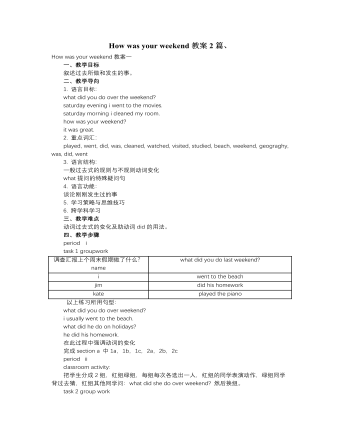
人教版新目标初中英语七年级下册How was your weekend教案2篇
Teaching Goal:1. General aims:Talk about recent past events2. Particular aims:A. Language Focus.Talk about recent past events and think of the past events.B. Language goalsHow was….?It was …What did …do over the weekend?C. Language structures:(1). How was your weekend? I was great. Pay attention to no form.(2). What did you do over the weekend? I played soccer. We went to the beach.D. Useful words and phrases:Words: was, did, went, beach, over, project, test, wasn’t, false, number, geography, spend, week, most, mixture, their, had, little, cook, read, saw, change, everyone, sit, sat, no, anythingPhrases: did one’s homework, played soccer, cleaned my room, went to the beach, played tennis, went to the movies, on Saturday morning, over the weekend, cook … for, what about, do some reading, have a party, talk show, go shoppingE. Grammar language:Present simple past tenseRegular and irregular verbsF. Learning strategies:Tour and holidaysG. Interdiscipinary:H. Emotion and manner:Teaching time: 5 periodsTeaching procedures:Period One教学步骤、时间 教师活动 学生活动 媒体应用Step 1Free talk 3’ Ask some questions like:Who’s on duty today?What’s the weather like? Answer and talk about something.让同学们回答下列问题1. Do you like weekend? (Let some students answer)It takes them three minutes to talk about the question.2. Why do you like weekend? (let the students answer) Most of the students like the weekend此时教师用汉语问:“在周末期间问你干了什么?这句话用英语这么回答?Let the students guess.At last the teacher give them right answer3. What did you do over the weekend?(板书、学习)

人教版新目标初中英语七年级下册Where is your pen pal from教案
2.1Match the country with the language.Step II Reading3a? let the students read the letter fast and answer the questions.? Let the students ask more questions about the letter as possible as the can.Step III Writing3b.Step IV. Pairwork2cStep V Listening2a, 2bStep V. HomeworkExercises book(1) P3Exercises book (2) P3Period FourStep I . Dictate the words and sentences in Unit1.Step II. Self-checkStep III. Check the answers for Exercises book in the unit.Step IV. Home workRevise and preparation for unit 2.教学反思:通过本单元的学习,学生基本可以谈论人们的国籍,居住城市及其所说的语言,通过书信方式去介绍自己并寻找笔友。但在涉及到国外的一些城市时,学生对这方面的知识相对欠缺,能介绍的城市并不多,也反应出学生课前预习不充分,这跟学生学习条件也有关,大多数学生无法通过网络获取所需信息。因此,在以后的教学中要多指导学生通过计算机网络获取信息,拓宽知识面。
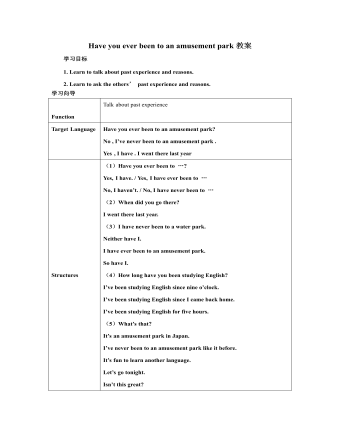
人教版新目标初中英语八年级下册Have you ever been to an amusement park教案
(1)Have you ever been to …? Yes, I have. / Yes, I have ever been to …No, I haven’t. / No, I have never been to …(2)When did you go there? I went there last year. (3)I have never been to a water park. Neither have I. I have ever been to an amusement park. So have I. (4)How long have you been studying English? I’ve been studying English since nine o’clock. I’ve been studying English since I came back home. I’ve been studying English for five hours. (5)What’s that? It’s an amusement park in Japan. I’ve never been to an amusement park like it before. It’s fun to learn another language. Let’s go tonight. Isn’t this great?space museum, amusement park, water park, South America, Peru, Holland, European culture, tour guide, flight attendant, musical instrument, more than, be from, get to, take lessons, neither, discover, graduate, change
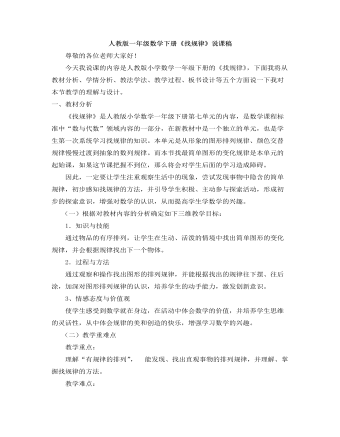
小学数学人教版一年级下册《找规律》说课稿
一、教材分析《找规律》是人教版小学数学一年级下册第七单元的内容,是数学课程标准中“数与代数”领域内容的一部分,在新教材中是一个独立的单元,也是学生第一次系统学习找规律的知识。本单元是从形象的图形排列规律、颜色交替规律慢慢过渡到抽象的数列规律。而本节找最简单图形的变化规律是本单元的起始课,如果这节课把握不到位,那么将会对学生后面的学习造成障碍。因此,一定要让学生注重观察生活中的现象,尝试发现事物中隐含的简单规律,初步感知找规律的方法,并引导学生积极、主动参与探索活动,形成初步的探索意识,增强对数学的认识,从而提高学生学数学的兴趣。(一)根据对教材内容的分析确定如下三维教学目标:1.知识与技能通过物品的有序排列,让学生在生动、活泼的情境中找出简单图形的变化规律,并会根据规律找出下一个物体。
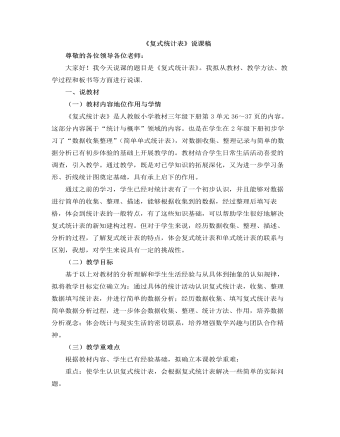
小学数学人教版三年级下册《复式统计表》说课稿
一、说教材(一)教材内容地位作用与学情《复式统计表》是人教版小学教材三年级下册第3单元36~37页的内容。这部分内容属于“统计与概率”领域的内容。也是在学生在2年级下册初步学习了“数据收集整理”(简单单式统计表),对数据收集、整理记录与简单的数据分析已有初步体验的基础上开展教学的。教材结合学生日常生活活动喜爱的调查,引入教学。通过教学,既是对已学知识的拓展深化,又为进一步学习条形、折线统计图奠定基础,具有承上启下的作用。通过之前的学习,学生已经对统计表有了一个初步认识,并且能够对数据进行简单的收集、整理、描述,能够根据收集到的数据,经过整理后填写表格,体会到统计表的一般特点,有了这些知识基础,可以帮助学生很好地解决复式统计表的新知建构过程。但对于学生来说,经历数据收集、整理、描述、分析的过程,了解复式统计表的特点,体会复式统计表和单式统计表的联系与区别,我想,对学生来说具有一定的挑战性。
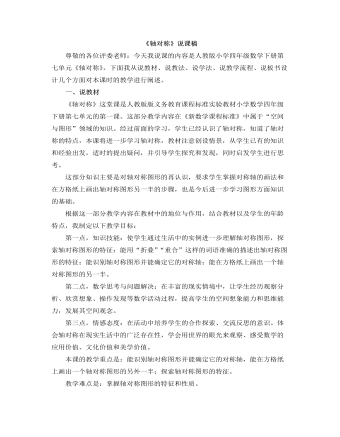
小学数学人教版四年级下册《轴对称》说课稿
第二环节:探究新知。本环节我设计了以下几个教学活动。活动一:让学生尝试说哪些是轴对称图形,并点名让学生动手对折,继而在学生总结时给出轴对称的定义。活动二:让学生动手尝试画对称轴后,自己动手在书本上画,在察看学生完成情况时及时纠正。活动三:出示两幅表格上的图让学生判别轴对称图形后,让学生尝试在表格上画出轴对称图形另一半后,进行步骤总结。[本环节的设计意图是:《数学课程标准》指出:“学生是数学学习的主人,教师是数学学习的组织者、引导者和合作者”。根据这一教学理念,在本环节中,我前后组织学生进行了几次自主探究活动,让学生在保持高度学习热情和探究欲望的活动过程中,始终以愉悦的心情,亲身经历和体验知识的形成过程。培养学生的探究能力、分析思维能力,激发他们的创新意识、参与意识;让学生在体验成功的同时也掌握和体会数学的学习方法。让学生在探究活动中,实现自主体验,获得自主发展。]
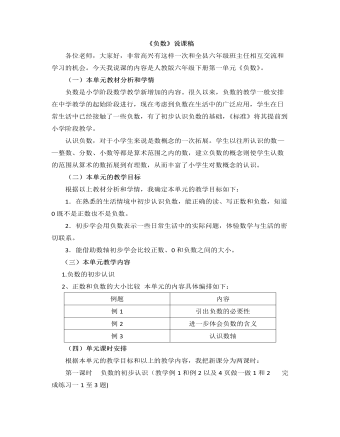
小学数学人教版六年级下册《负数》说课稿
(一)本单元教材分析和学情负数是小学阶段数学教学新增加的内容。很久以来,负数的教学一般安排在中学教学的起始阶段进行,现在考虑到负数在生活中的广泛应用,学生在日常生活中已经接触了一些负数,有了初步认识负数的基础,《标准》将其提前到小学阶段教学。认识负数,对于小学生来说是数概念的一次拓展。学生以往所认识的数——整数、分数、小数等都是算术范围之内的数,建立负数的概念则使学生认数的范围从算术的数拓展到有理数,从而丰富了小学生对数概念的认识。(二)本单元的教学目标根据以上教材分析和学情,我确定本单元的教学目标如下:1.在熟悉的生活情境中初步认识负数,能正确的读、写正数和负数,知道0既不是正数也不是负数。2.初步学会用负数表示一些日常生活中的实际问题,体验数学与生活的密切联系。
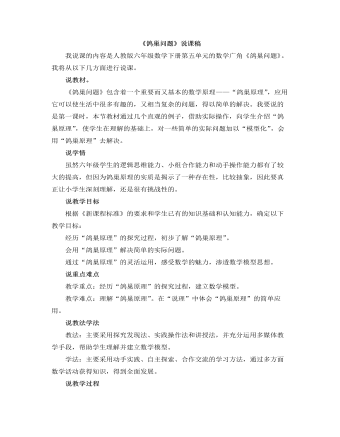
小学数学人教版六年级下册 《鸽巢问题》说课稿
说教材。《鸽巢问题》包含着一个重要而又基本的数学原理——“鸽巢原理”,应用它可以使生活中很多有趣的,又相当复杂的问题,得以简单的解决。我要说的是第一课时,本节教材通过几个直观的例子,借助实际操作,向学生介绍“鸽巢原理”,使学生在理解的基础上,对一些简单的实际问题加以“模型化”,会用“鸽巢原理”去解决。说学情虽然六年级学生的逻辑思维能力、小组合作能力和动手操作能力都有了较大的提高,但因为鸽巢原理的实质是揭示了一种存在性,比较抽象,因此要真正让小学生深刻理解,还是很有挑战性的。说教学目标根据《新课程标准》的要求和学生已有的知识基础和认知能力,确定以下教学目标:经历“鸽巢原理”的探究过程,初步了解“鸽巢原理”。会用“鸽巢原理”解决简单的实际问题。通过“鸽巢原理”的灵活运用,感受数学的魅力,渗透数学模型思想。
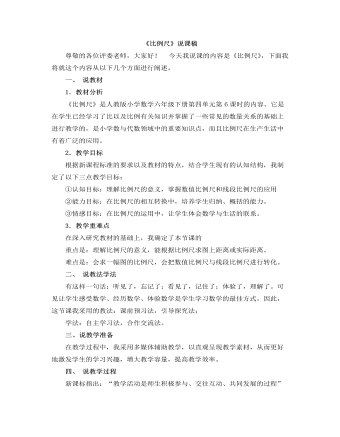
小学数学人教版六年级下册《比例尺》说课稿
2.教学目标根据新课程标准的要求以及教材的特点,结合学生现有的认知结构,我制定了以下三点教学目标:①认知目标:理解比例尺的意义,掌握数值比例尺和线段比例尺的应用 ②能力目标:在比例尺的相互转换中,培养学生归纳、概括的能力。 ③情感目标:在比例尺的运用中,让学生体会数学与生活的联系。3.教学重难点在深入研究教材的基础上,我确定了本节课的重点是:理解比例尺的意义,能根据比例尺求图上距离或实际距离。难点是:会求一幅图的比例尺,会把数值比例尺与线段比例尺进行转化。二、 说教法学法有这样一句话:听见了,忘记了;看见了,记住了;体验了,理解了。可见让学生感受数学、经历数学、体验数学是学生学习数学的最佳方式。因此,这节课我采用的教法:课前预习法,引导探究法;学法:自主学习法,合作交流法。
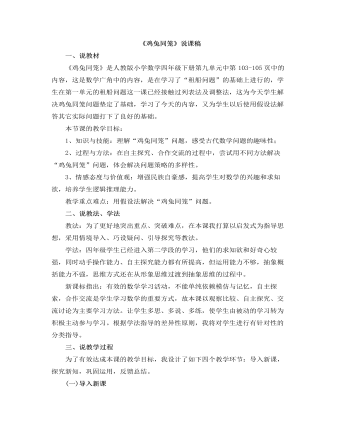
小学数学人教版四年级下册《鸡兔同笼》说课稿
【这样的导入,符合学生的心理特点,激发了学生的好奇心和探究欲望,让学生在猜谜中不知不觉地进入学习状态。顺利过渡到第二个探究新知的教学环节。】(二)探究新知 这一环节我设计了如下2个步骤:一、理解题意;二、探究方法 1. 理解题意课件出示104页的例1,请学生读题并说一说从题中了解到了哪些信息,如果学生只说出从题目中可以知道鸡和兔加起来总共有8只,脚共有26只,引导学生说出题目中隐含的信息,即鸡有两只脚,兔子有四只脚。2.探究方法根据从题目中收集的信息,请学生们分小组交流讨论,用哪些方法可以找到答案。教师在教室里巡视指导,找出学生想到的不同方法并收集起来。学生可能想到很多种不同的方法,我用实物投影仪从易到难呈现给学生观察并交流讨论。学生可能想到以下方法:
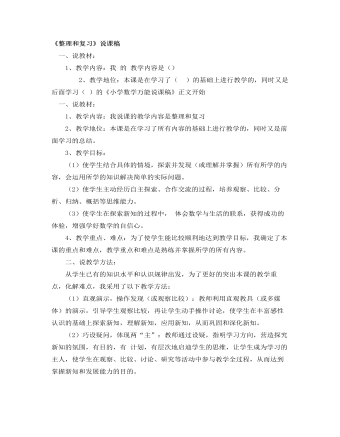
小学数学人教版六年级下册 《整理和复习》说课稿
一、说教材:1、教学内容:我说课的教学内容是整理和复习2、教学地位:本课是在学习了所有内容的基础上进行教学的,同时又是前面学习的总结。3、教学目标:(1)使学生结合具体的情境,探索并发现(或理解并掌握)所有所学的内容,会运用所学的知识解决简单的实际问题。(2)使学生主动经历自主探索、合作交流的过程,培养观察、比较、分析、归纳、概括等思维能力。(3)使学生在探索新知的过程中, 体会数学与生活的联系,获得成功的体验,增强学好数学的自信心。4、教学重点、难点:为了使学生能比较顺利地达到教学目标,我确定了本课的重点和难点,教学重点和难点是熟练并掌握所学的所有内容。
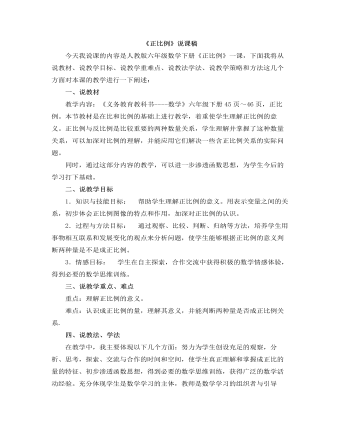
小学数学人教版六年级下册《正比例》说课稿
在本节课中,我着重引导学生,在独立思考的基础上,学会小组合作交流。具体表现在学会思考,学会观察,学会表达,学会思考教师要设计好问题,学会观察教师要指导学生观察表格和图像,学会表达教师要引导学生如何说,并对学生进行激励性的评价,让学生乐于说,善于说。五、说教学策略和方法活动一:复习引入:1.复习:己知路程和时间,怎样求速度?己知总价和数量,怎样求单价?己知工作总量和工作时间,怎样求效率?2.引入课题:这是我们过去学过的一些常见的数量关系。这节课我们进一步来研究这些数量关系的一些特征,首先来研究这些数量之间的正比例关系。板书课题:成正比例的量。【设计意图:在引入过程中,我引导每个学生去思考一组组相关联的量,能用语言叙述,学生通过这一过程,可以深刻感受到生活中存在着大量的相关联的量。本节课的内容比较抽象,较难理解所以我采用复习旧知,引发兴趣来导入新课,让学生将知识联系到生活,使他们乐于学习。】
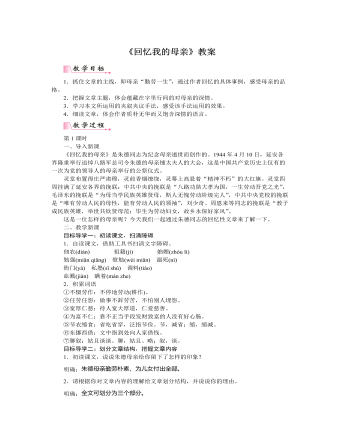
部编版语文八年级上册《回忆我的母亲》教案
这一句议论,呼应前文的记叙——母亲教“我”生产的知识,同情革命、支持革命,让“我”养成革命的意志。这些都是“我”感谢母亲的重要原因。“母亲是一个平凡的人,她只是中国千百万劳动人民中的一员,但是,正是这千百万人创造了和创造着中国的历史。”母亲勤苦一生,任劳任怨,反抗地主豪绅的欺压,坚强不屈,母亲就是一位普普通通的农妇,她是“平凡的”,但正是像母亲这样的千百万劳动人民,融汇成革命的洪流,推动着历史的发展,为我们的民族做出了不可磨灭的贡献,中国的现在、未来都将是劳动人民的。这句议论,将对母亲的深情与对民族、对广大劳动人民的深情融汇在一起。
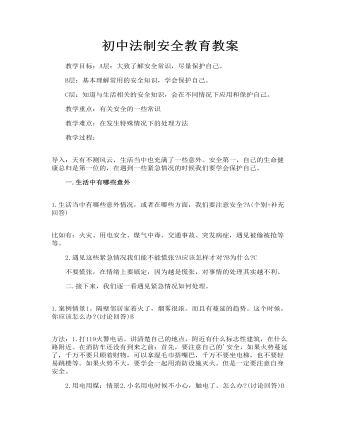
初中法制安全教育教案
一.生活中有哪些意外 1.生活当中有哪些意外情况,或者在哪些方面,我们要注意安全?A(个别+补充回答) 比如有:火灾、用电安全、煤气中毒、交通事故、突发病症,遇见被偷被抢等等。 2.遇见这些紧急情况我们能不能慌张?A应该怎样才对?B为什么?C 不要慌张,在情绪上要镇定,因为越是慌张,对事情的处理其实越不利。
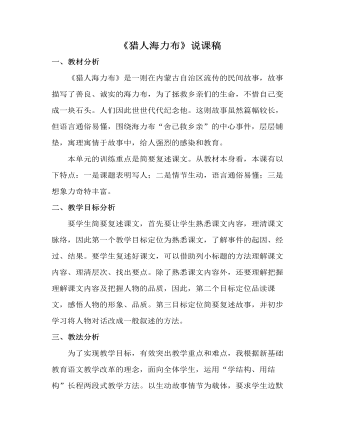
部编人教版五年级上册《猎人海力布》说课稿
一、教材分析《猎人海力布》是一则在内蒙古自治区流传的民间故事,故事描写了善良、诚实的海力布,为了拯救乡亲们的生命,不惜自己变成一块石头。人们因此世世代代纪念他。这则故事虽然篇幅较长,但语言通俗易懂,围绕海力布“舍己救乡亲”的中心事件,层层铺垫,寓理寓情于故事中,给人强烈的感染和教育。本单元的训练重点是简要复述课文。从教材本身看,本课有以下特点:一是课题表明写人;二是情节生动,语言通俗易懂;三是想象力奇特丰富。二、教学目标分析要学生简要复述课文,首先要让学生熟悉课文内容,理清课文脉络,因此第一个教学目标定位为熟悉课文,了解事件的起因、经过、结果。要学生复述好课文,可以借助列小标题的方法理解课文内容、理清层次、找出要点。除了熟悉课文内容外,还要理解把握理解课文内容及把握人物的品质,因此,第二个目标定位品读课文,感悟人物的形象、品质。第三目标定位简要复述故事,并初步学习将人物对话改成一般叙述的方法。
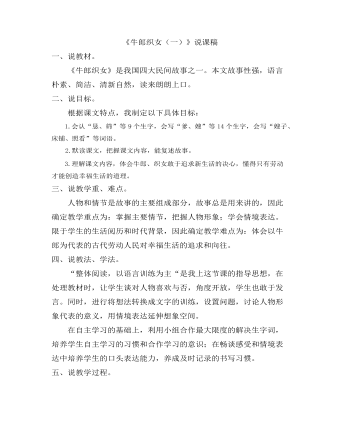
部编人教版五年级上册《牛郎织女(一)》 说课稿
三、说教学重、难点。人物和情节是故事的主要组成部分,故事总是用来讲的,因此确定教学重点为:掌握主要情节,把握人物形象;学会情境表达。限于学生的生活阅历和时代背景,因此确定教学难点为:体会以牛郎为代表的古代劳动人民对幸福生活的追求和向往。四、说教法、学法。“整体阅读,以语言训练为主“是我上这节课的指导思想,在处理教材时,让学生谈对人物喜欢与否,角度开放,学生也敢于发言。同时,进行将想法转换成文字的训练,设置问题,讨论人物形象代表的意义,用情境表达延伸想象空间。
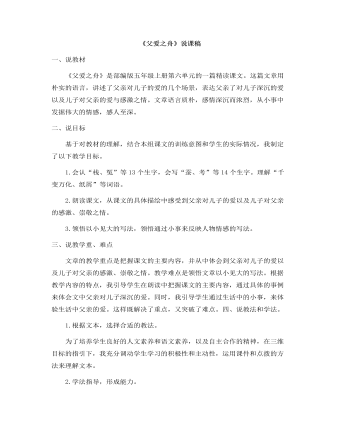
部编人教版五年级上册《父爱之舟》说课稿
一、说教材《父爱之舟》是部编版五年级上册第六单元的一篇精读课文。这篇文章用朴实的语言,讲述了父亲对儿子的爱的几个场景,表达父亲了对儿子深沉的爱以及儿子对父亲的爱与感激之情。文章语言质朴,感情深沉而浓烈,从小事中发掘伟大的情感,感人至深。二、说目标基于对教材的理解,结合本组课文的训练意图和学生的实际情况,我制定了以下教学目标。1.会认“栈、冤”等13个生字,会写“蚕、考”等14个生字。理解“千变万化、纸屑”等词语。2.朗读课文,从课文的具体描绘中感受到父亲对儿子的爱以及儿子对父亲的感激、崇敬之情。3.领悟以小见大的写法,领悟通过小事来反映人物情感的写法。
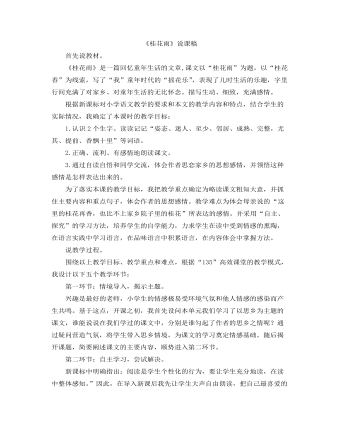
部编人教版五年级上册《 桂花雨》说课稿
首先说教材。《桂花雨》是一篇回忆童年生活的文章,课文以“桂花雨”为题,以“桂花香”为线索,写了“我”童年时代的“摇花乐”,表现了儿时生活的乐趣,字里行间充满了对家乡、对童年生活的无比怀念。描写生动、细致,充满感情。根据新课标对小学语文教学的要求和本文的教学内容和特点,结合学生的实际情况,我确定了本课时的教学目标:1.认识2个生字。读读记记“姿态、迷人、至少、邻居、成熟、完整,尤其、提前、香飘十里”等词语。2.正确、流利、有感情地朗读课文。3.通过自读自悟和同学交流,体会作者思恋家乡的思想感情,并领悟这种感情是怎样表达出来的。
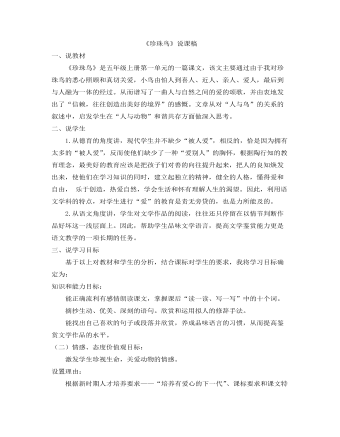
部编人教版五年级上册《 珍珠鸟》说课稿
二、说学生 1.从德育的角度讲,现代学生并不缺少“被人爱”,相反的,恰是因为拥有太多的“被人爱”,反而使他们缺少了一种“爱别人”的胸怀,根据陶行知的教育理念,最美好的教育应该是把孩子们对善的向往提升起来,把人的良知焕发出来,使他们在学习知识的同时,建立起独立的精神,健全的人格,懂得爱和自由, 乐于创造,热爱自然,学会生活和怀有理解人生的渴望。因此,利用语文学科的特点,对学生进行“爱”的教育是责无旁贷的,也是力所能及的。2.从语文角度讲,学生对文学作品的阅读,往往还只停留在以情节判断作品好坏这一浅层面上。因此,帮助学生品味文学语言,提高文学鉴赏能力更是语文教学的一项长期的任务。
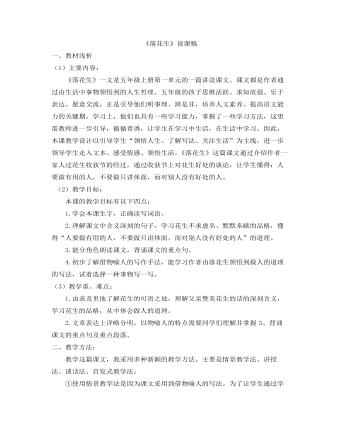
部编人教版五年级上册《 落花生》说课稿
(1)主要内容:《落花生》一文是五年级上册第一单元的一篇讲读课文。课文都是作者通过由生活中事物领悟到的人生哲理。五年级的孩子思维活跃、求知欲强、乐于表达、愿意交流,正是引导他们明事理、辨是非,培养人文素养、提高语文能力的关键期。学习上,他们也具有一些学习能力,掌握了一些学习方法,这更需教师进一步引导,循循善诱,让学生在学习中生活,在生活中学习。因此,本课教学设计以引导学生“领悟人生、了解写法、关注生活”为主线,进一步领导学生走入文本、感受情感、领悟生活。《落花生》这篇课文通过介绍作者一家人过花生收获节的经过,通过收获节上对花生好处的谈论,让学生懂得:人要做有用的人,不要做只讲体面,而对别人没有好处的人。(2)教学目标:本课的教学目标有以下四点:1.学会本课生字,正确读写词语。

